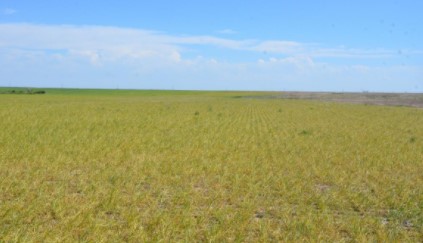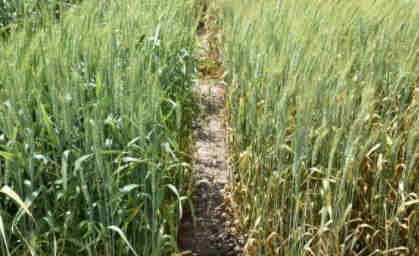By Stephen Wegulo
Extension Plant Pathologist
Nebraska growers have been severely affected by stripe rust (Figure 1) in their wheat crops for the last decade, particularly in the western half of the state. Stripe rust is not necessarily a new disease, but it has become much more prevalent and more problematic than the other wheat rust disease (leaf rust), which has historically been our major rust disease.
Furthermore, 2017 was a horrendous year for growers with the virus disease wheat streak mosaic (Figure 2). Numerous fields throughout the Panhandle were severely diseased and many were not harvested.
In an effort to reduce these problems in 2018, several steps can be taken (or at least considered) before you plant your wheat in the next few weeks. These steps will not only help manage stripe rust and wheat streak mosaic, but can also assist in achieving a good stand and a healthy, vigorously growing crop prior to its entering dormancy this winter. Many of our wheat problems are due to stresses such as root diseases (Figure 3). These stresses result in overall weaker crops, allowing a greater degree of susceptibility when other biotic stresses arrive the following spring. The quicker the stands become established in the fall, the healthier they are before going into dormancy. This also allows better responses to additional stresses the following spring.

Figure 2. Wheat streak mosaic in a grower’s field in Deuel County in May 2017.
5 Steps to a Healthy Wheat Crop
Consider taking these steps prior to planting to provide your wheat with a healthy start:
- Use recommended planting date.
- Plant recommended cultivars with tolerance to stripe rust or other biotic stresses.
- Plant into a firm, but yet mellow seedbed.
- Control wheat volunteers from recently harvested fields and weeds in summer fallow.
- Treat seeds with an appropriate fungicide.
1. Use recommended planting date. Research years ago by UNL personnel indicated that planting date recommendations should be made in relation to elevation. For areas of western Nebraska, the general guideline for planting to minimize stress and early infection of plants was to use 4,000 feet as a baseline and Sept. 10 as a base date. Each 100-foot difference in elevation from that base would be a one-day difference in planting date. The lower the elevation, the later the best planting date. For example, Banner County (3,800 feet) would have an optimal planting date of Sept. 15. Box Butte or Cheyenne County (4,000 feet) would be Sept. 10, and Kimball County (5100 feet) would have a date of Sept 1.

Figure 3. Blackening of roots caused by Bipolaris, a wheat root and crown rot pathogen

Figure 4. A stripe rust resistant wheat variety (left) and a susceptible variety in a University of Nebraska-Lincoln research plot in June 2017
2. Plant tolerant cultivars. Using cultivars with some resistance to a disease (for example, stripe rust and/or wheat streak mosaic) wherever possible will help avoid or at least delay infection. In general, plants that become infected later also lower their chance of severe damage. Disease tolerance also may delay infection enough that a fungicide application will not be necessary, depending upon environmental conditions.
3. Plant into a firm, but yet mellow seedbed. The chances that pathogens will cause crown and root rot disease increase when planting in either a loose or compacted seedbed. This puts another stress on affected plants, predisposing them to other problems later.
4. Control weeds and volunteer wheat in wheat fields and summer crops. These plants remove soil moisture, resulting in greater drought stress to plants, which in turn predisposes plants to other stresses (rot and crown infection, stripe rust, etc.) later. Volunteer wheat also can serve as a reservoir for wheat curl mites, vectors of the wheat streak mosaic virus pathogen. Volunteer wheat creates a “green bridge” which the mites use to travel from one wheat crop to the next. Early infection by the wheat streak mosaic virus will cause greater damage in spring when plants come out of dormancy and temperatures begin to rise. This was the primary factor in the high incidence and severity of virus problems in 2017. Most problem fields were damaged by or near fields damaged by hailstorms in 2016; in these fields the resulting volunteer was not controlled and served as green bridge.
5. Treat seeds with an appropriate fungicide. The pathogens causing root rots (Fusarium, Rhizoctonia, Bipolaris) are naturally occurring residents in the soil and never go away once established. When they infect early after planting in the fall, they do not always kill the plants, but can cause a subtle, often unnoticed yield drag that provides another stress predisposing plants to other problems the following spring. Fungicide treatments help the plants avoid early infection, establishing healthy stands.
Source: unl.edu